Legend 4-day Cruise
Galapagos Ecuador: (ZZ-EC-GALP07-3)
URL: https://www.hiddentrails.com/tour/outdoor_ecuador_Galapagos_legend_cruise3.aspx
Introduction
Galapagos
Ecuador
Galapagos Legend 100 passengers
This magnificent vessel, with a capacity for 100 guests, has the charm of The Enchanted Islands; it is still small enough for a more intimate experience with friends and family. With her three different decks, the Galapagos Legend offers a great variety of comfortable and spacious social areas without losing its sense of intimacy. Its fantastic open decks allow you to admire the islands’ flora and fauna, enjoy a BBQ at night, or take some sun at the pool and bar areas.
Take advantage of its spacious inside auditorium for important conferences. Our philosophy is based on an environment without any formalisms or strict etiquette.
The facilities focus on both mind and body and provide you with those special places you need to exercise, rest or relax in a peaceful , harmonious setting.
The exceptional cuisine is comparable to that of the best restaurants in the world and merit special mention, ranging from the impressive breakfast buffet with freshly baked bread to the extraordinary menus drawn up by professional chefs for lunch and dinner. Visitors will enjoy local gastronomy, a wide variety of exotic fruits and the world’s best flavors, special menus for children, delicious vegetarian dishes or meals for those who have special diets. Once a week, there will be a barbecue at sea so you can sail, dine and enjoy islands landscapes.
Enjoy a charming casual marine décor, with accommodations in cabins with a view of the sea, delicious meals, 2 daily excursions to a habitat unlike any other, full of wildlife that have no fear of man. See prehistoric iguanas, giant tortoises, exotic birds and plants and beautiful landscape of volcanoes, lava cones and magma flows. Snorkel or dive along untouched beaches with a unique underwater world. Tours and lectures provided by licensed nature guides in various languages.
Relax
To relax in the sun or even bathe in the Jacuzzi, head to the Earth Deck, where the natural wonders of the Galapagos can be enjoyed from a whole different perspective, whether by the handrail of their decks, the comfort of a sun-lounger or from the balcony at the bow. There’s a space for everyone on these deceptively large yachts. Take a peak into our boutique for your shopping needs. On our new Sky Deck, view the dolphins playing in the water, swim in our pool, watch the wave from our panorama lounge inside with a drink from the Fisherman bar.
Enjoy
Enjoy the various activities on board. Enjoy our high-class gym. On board our ship, nights are magical, full of bright stars and countless constellations.
Learn
All of our highly-qualified multi-lingual naturalist guides are certified by the Galapagos National Park. On visits to the islands, they will accompany you every step of the way, taking time to explain the highlights as you wonder through this new and magical land. Every evening, these same guides will give you a lecture illustrated with multimedia presentation, imparting and sharing with you their knowledge of geology, history, evolution, flora and fauna of the islands. Also enjoy our library and for the little ones kid's corner where they can learn all about the Galapagos!
Feel Safe
Our customers’ safety and the conservation and respect for the environment are our main priorities. Our vessels comply with local and international standards enforced by ISM (International Management Code for the Safe Operation of Ships and for Pollution Prevention). Our crews are all highly trained in safety procedures and have years of experience at sea.
Accomodation
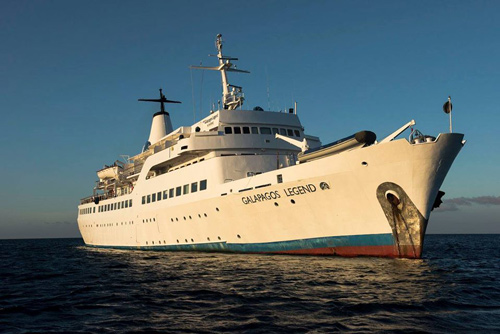
Accommodations
All nights of this trip are spent on the Legend. This impressive vessel, with capacity for 100 guests (56 cabins total), was refurbished in 2019. As well as being the fastest cruise ship operating in the Islands, it remains the only vessel with an onboard pool.
Beyond what you might expect, the Legend is equipped with a glass-bottom boat, transparent kayaks, a kid’s corner, a naturalist center, cinema, a boutique, snorkeling equipment room and a full auditorium facility.
There is also a wellness center (extra fee) that provides massages à la carte, yoga sessions and a gym.
There are 7 different cabin categories:
- Standard Cabin (3 cabins)
- Standard Plus Cabin (7 cabins)
- Junior Suite (24 cabins)
- Junior Suite Plus (4 cabins)
- Balcony Suite (10 cabins)
- Balcony Suite Plus (7 cabins)
- Legend Balcony Suite (1 cabin)
Each cabin includes a private bathroom (with hair dryer & toiletries), phone (local calls only), safe deposit box, air conditioning and a TV.
Voltage is set for 110 volts/60 Hz. There is Wi-Fi access in the lounge area.
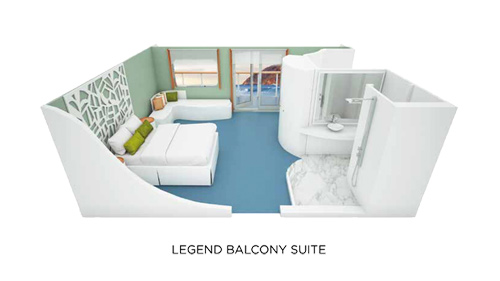
LEGEND BALCONY SUITE - measuring 33 m2 (355 ft2)
Double and triple occupancy possible.
This is our most comfortable cabin, including panoramic windows and a large balcony.
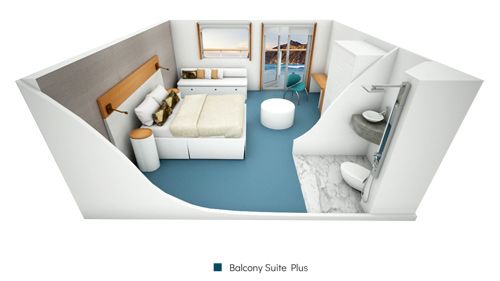
BALCONY SUITE PLUS - measuring an average of 22 m2 (237 ft2)
Double & triple occupancy possible.
They include panoramic windows and a balcony.
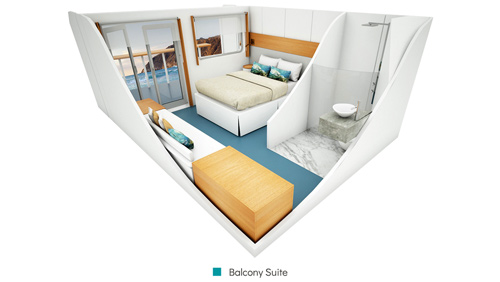
BALCONY SUITE - measuring an average of 22 m2 (237 ft2)
Double & triple occupancy possible.
They include panoramic windows and a balcony.
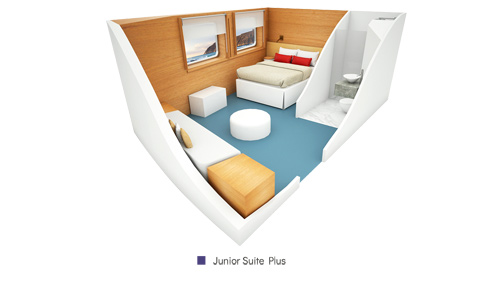
JUNIOR SUITE PLUS - measuring an average of 20 m2 (215 ft2)
Double, triple & quadruple occupancy possible. Interconnected cabins available.
There are 2 panoramic windows per cabin.
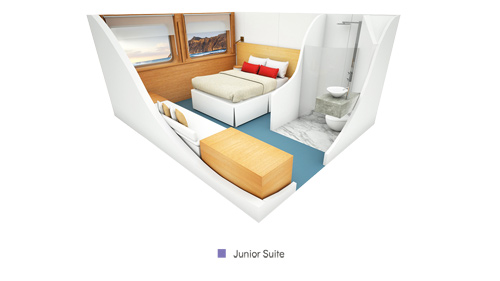
JUNIOR SUITE - measuring an average of 15 m2 (161 ft2)
Double & triple occupancy possible. Interconnected cabins available.
There are 2 panoramic windows per cabin.
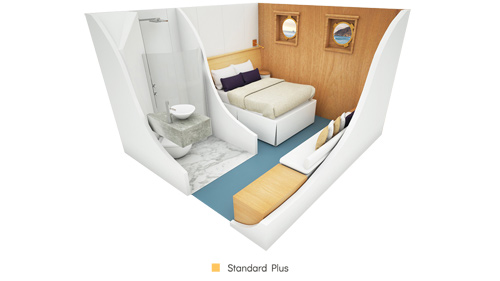
STANDARD PLUS - measuring an average of 11 m2 (118 ft2)
Double & single occupancy possible.
There are 2 portholes per cabin.
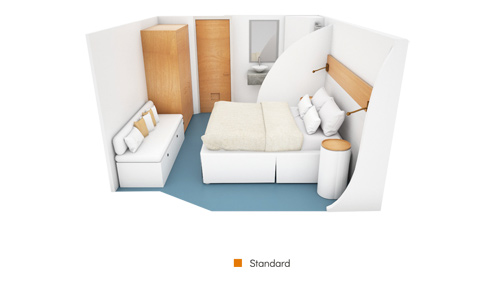
STANDARD INTERIOR - measuring an average of 13 m2 (140 ft2)
Double & single occupancy possible.
These cabins are located in the interior, so there are no ocean view.
Additional onboard services and facilities include:
• Drying machines available for complimentary use
• Variety of onboard activities
• Briefings on the following day’s activities
• Informative lectures about the Galapagos
• Medical attention 24 hours a day
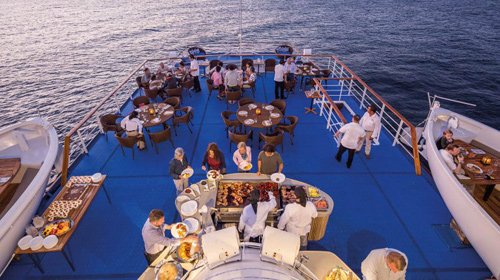
Meals
All meals are included during the cruise.
Lonesome George Restaurant
This acclaimed restaurant will surprise you with its wide range of mouth-watering, culinary delights. Using fresh ingredients, we serve a high level of international and local cuisine from our professional chefs. With an à la carte dinner, we offer a vegetarian and children’s menu. We also provide a kosher-friendly option with tableware and a private restaurant available upon request.
Al Fresco Restaurant
BBQ dinner amid the islands in a buffet-style meal with a great selection of cuts, sea food, vegetables, and salad options. Two lifeboats with tables can accommodate up to 14 people each for a unique dining experience. Reliant on the weather, this meal in the open space might be subject to change either for breakfast or lunch.
Make the most of your cruise experience with our beverage packages (not included in tour price - to be paid extra) that offer a range of soft drinks, local beer, a selection of sparkling wines and classic cocktails to be served at our bars and restaurants.
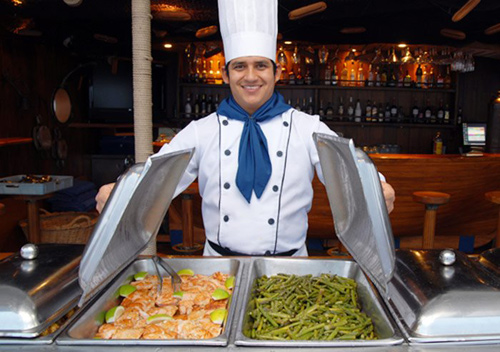
Riding
Staff
Every crew member is trained to provide a first-class service with exceptional professionalism. Genuinely friendly individuals, fully dedicated to providing the best hospitality services, with attention to detail
and personalized assistance, our crew’s passion and commitment create a one-of-a-kind experience for our guests.
Physical requirement for the cruise
We recommend that passengers be in reasonably good physical condition as some trails are difficult therefore elderly or disabled people may find them too hard. The passengers with difficulties must notify us about their physical condition in order to make the necessary arrangements.
We reserve the right to refuse a passenger if someone failed to inform of any physical disability, or who in the opinion of the company, constitutes a danger to themselves, other guest, members of the crew, or the smooth operation of the vessel.
Dry Landings and Wet Landings
On a dry landing, passengers step directly from a dinghy to rocks or onto a dock. We recommend: walking shoes, sunscreen, hat, water, insect repellent and a light jacket.
Wet Landing means that the dinghy edges up onto a beach, where you step into knee-deep water assisted by crew members and guides. We recommend: swimming suit or shorts, walking shoes or slippers, towel that will be provided by the crew while disembarking, sunscreen, hat, insect repellent, plastic bag, well insulated cameras and a windbreaker.
Smoking policy on board the ship
It is forbidden to smoke inside the yachts or the vessel.
Smoking is allowed ONLY on the sun decks.
How can I pay my expenses on board?
Upon arrival, a bill will be opened for you. If you wish to pay with your credit card, we ask you to come to reception to sign a voucher and to make copies of your passport and credit card. Authorizations take about 48 hours, so please do this on your first cruise day. We accept all main credit cards: Diners, Visa, Mastercard , American Express. Travellers Checks, Euros and US Dollars are also accepted.
What would happen if I get seasick?
We hardly get a seasick passenger on board. However, we have seasick medication on board all our ships, but if you are particularly sensitive you can bring your own medication.
Is the water safe to drink?
The tap water is generally not safe to drink in Ecuador. Bottled water is readily available at tourist sites, hotels, and restaurants. On board our yachts you will find bottled water in your room. Ice used onboard the yachts is generally made with purified water as well.
Itinerary
Sample Itinerary: Central option - subject to changes
Day 1 (Monday): Arrival & Santa Cruz Island Visit
Departure from Quito or Guayaquil to Baltra (2 ½ hours flight). Passengers are picked up at the airport by our naturalist guides and taken on a ten minute bus drive to the pier to board the Galapagos Legend.
This afternoon, dry landing on Santa Cruz Island. In the mountains of Galapagos, it is possible to admire different kinds of birds, such as tree and ground finches, vermillion flycatchers, paint-billed crakes, yellow warblers, and cattle egrets (usually standing on the tortoises’ shell). The journey to the reserve offers great opportunities to see the contrasts that the island offers in reference to the variety of ecosystems. The road goes from the coast through the agricultural zone and straight up to the dense humid forests. Often, Galapagos Giant Tortoises are also seen on the way, wandering through pastures in the paddocks. This spot is a bird watchers’ haven since almost every land bird present on the island lives or migrates here.
Activity Difficulty: easy (flat & muddy sometimes - seasonal conditions)
Activity Duration: 45-minute drive / 1 ½-hour walk
Day 2 (Tuesday): Genovesa Island
When visiting Prince Philip’s Steps (also known as 'El Barranco'), be marveled at the variety of sea life that uses the crevices of the lava cliffs for shelter. Red-billed Tropicbirds fly overhead, switching between their nests and the bay, and a small colony of fur seals may be found near the landing site. You will be dropped off at a steep stairway that begins on rocks at the foot of a path that leads through a seabird colony full of Nazca and Red-footed Boobies. At the plateau, the trail continues inland allowing you to see more nesting booby colonies in the thin Palo Santo forest. Near the end of the trail, over a rocky lava plain, Wedge-rumped Storm-Petrels can be observed flying in all directions. If you are lucky, you may catch a glimpse of a Short-eared Owl.
Activity Difficulty: Moderate (rocky terrain – lava)
Activity Duration: 45-minute walk
In the afternoon, disembark onto a small sand and coral beach: Darwin Bay. A short trail heads west along a tidal lagoon and then up a rocky hill that leads to a point overlooking the cliffs and Darwin Bay. Along the trail near the tidal lagoon, visitors will see pairs of Swallow-tailed Gulls, Lava Gulls, Yellow-crowned and Lava Herons. The trail continues through Palo Santo trees, Opuntia cacti, and Saltbushes inhabited by Great Frigate birds and Red-footed Boobies. This is one of the few places in the islands where visitors are guaranteed to see Red-footed Boobies. It is estimated that more than 200,000 Red-footed Boobies live in the trees and bushes of Genovesa.
Activity Difficulty: Moderate (Sand & Lava)
Activity Duration: approx. 2 ½-hour walk
Day 3 (Wednesday): Dragon Hill & Santa Fe Island
After breakfast, dry landing at Dragon Hill (Santa Cruz Island). Walk by a brackish lagoon to see flamingos. The trail leads across typical dry zone vegetation. Keeping up until Dragon Hill, see an important nesting ground for endemic land iguanas, offering lovely views of the anchored boats and neighboring islands. The forest is home to mockingbirds, Darwin’s finches, yellow warblers, and Galapagos doves.
Activity Difficulty: intermediate (rocky terrain)
Activity Duration: 2-hour walk
Later that day, wet landing on Santa Fe island. this island shows white sand beaches surrounded by sea lion colonies; through the island path, an endemic cactus forest is passed, home the Santa Fe land iguanas (the largest in the islands). This island is the habitat for a number of species, including the Galapagos hawk, Galapagos snakes, rice rats (one of the few endemic Galapagos rodents), a variety of finches and one of the four mockingbird species of the archipelago.
Activity Difficulty: intermediate (rocky terrain)
Activity Duration: 1 ½-hour walk / 1-hour deep-water snorkeling
Day 4 (Thursday): Departure
For our last expedition, wet landing at Bachas Beach. On the north side of Santa Cruz; behind the beach lies two small flamingo ponds were iguanas sunbathe, see coastal birds, Darwin finches, mockingbirds, and gulls, as well as interesting native vegetation like red and black mangrove, salt bushes. This beach is one of the main sea turtles nesting sites in the Galapagos. A turtle can lay eggs 3 or 4 times per season with an average of 70 eggs each time. At this paradisiacal site, we will also find the remains of barges that sank a long time ago, when the United States Navy operated a base during World War II on Baltra Island. Local people modified the word barges to “Bachas”.
Activity Difficulty: easy (sandy terrain)
Activity Duration: 1-hour walk / 1-hour snorkeling/ beach time
After the visit, passengers will be transferred to the airport for their return flight to Guayaquil or Quito.
Sample Itinerary: East option - subject to changes
Day 1 (Monday): Arrival & North Seymour Island Visit
Departure from Quito or Guayaquil to Baltra (2 ½ hours flight). Passengers are picked up at the airport by our naturalist guides and taken on a ten minute bus drive to the pier to board the Galapagos Legend.
This afternoon, visit of North Seymour Island. This flat, uplifted, island is an important spot to see both magnificent and great frigatebird males courting the females by clicking, bill-clapping, shuddering and flapping their wings, all while showing off their grossly inflated, bright red, gular pouch. We will also likely see courting blue-footed boobies displaying their unique feet while dancing to a prospective mate. Sea lions, swallow-tailed gulls, crashing surf and distant views of the Daphne Islands top off a great visit.
Difficulty level: intermediate (rocky terrain)
Duration: 2-hour walk, 30 minutes snorkeling
Day 2 (Tuesday): Bartolome & Santiago Island
This morning, we explore Bartolome island. Considered the most iconic landscape of the entire archipelago the view from the top of Bartolome Island, overlooking the famous Pinnacle Rock and the austere Santiago Island beyond, is well worth the climb up the wooden boardwalk. This volcanic scene has often been likened to a lunar landscape. Our subsequent snorkel here might put us face to face with Galapagos penguins, white-tipped reef sharks and playful sea lions.
Difficulty level: intermediate (trail made of 372 steps)
Duration: 1 ½-hour walk / 1-hour snorkeling
After lunch, wet landing in Sullivan Bay. This site is located at the southeastern portion of Santiago island and is of important geologic interest. It features extensive relative Young pa-hoe-hoe lava flows formed during the last quarter of the 19th century. In the middle of the lava flow, older reddish-yellow-colored tuffe cones appear. Mollugo plants with their yellow-to-orange whorled leaves usually grow out of the fissures. Walking on the solidified lava gives the impression of being on another planet. tree modls are found, indicating that in that position, large size palnts gre in small crevices, until the lava flow of past éruptions burnt down the flora of the island.
Activity Difficulty: difficult (flat volcanic lava terrain)
Activity Duration: 1.5 hour walk / 1 hour snorkeling
Day 3 (Wednesday): San Cristobal Island
Our exploration of San Cristobal island starts with a wet landing at Pitt Point, followed by a high intensity hike. The trail includes an olivine beach of 90 meters long and a path that climbs to the top of a volcanic tuff, through several magnificent viewpoints. This is probably the only site where the three booby species of the Galapagos can be seen together, as well as two species of frigatebirds and a sea lion colony; it is also excellent for dinghy rides and snorkeling, where a good range of sea birds can be observed.
Activity Difficulty: difficult (rocky terrain)
Activity Duration: 2h30 walk/ 40-minutes snorkeling or kayaking
In the afternoon, wet landing at Cerro Brujo, an eroding tuff cone that at several locations is composed of AA lava formations, and a beautiful white sand beach, great for snorkeling and sunbathing. We visit a lagoon where migratory bird species can be seen: Black-necked Stilts, Ruddy Turnstones, Whimbrels, other sandpiper species and White-cheeked Pintails. Cerro Brujo offers beautiful views of Kicker Rock, the southern part of San Cristobal and the adjacent coast.
Activity Difficulty: easy (sandy terrain)
Activity Duration: 1-hour walk / 1-hour snorkeling
Day 4 (Thursday): Departure
For our last morning expedition, we visit the moist Highlands of San Cristobal island. We will visit the giant tortoise breeding center La Galapaguera, to witness the most iconic creature of the archipelago in its various life stages. The tortoises wander in a semi-natural habitat which lends itself to good photographic opportunities. the aim of the reserve is to help restore populations of the threatened San Cristobal tortoises back into the wild. In town, there are shops to purchase local handicrafts and souvenirs.
Activity Difficulty: intermediate (sandy terrain)
Activity Duration: 40-minute bus drive to the Reserve / 1-hour visit
After the visit you will go straight to the airport for return flight to Guayaquil or Quito.
Rates and Dates for Legend 4-day Cruise
Rates include:
Accommodation, All meals, Welcome & farewell cocktails, Coffee / tea station, 2 daily excursions, Multilingual naturalist guides (English/Spanish), Snorkeling opportunities, Optional Diving, Fuel surcharge, Free Shuttle service from Quito/Guayaquil Airport-roundtrip (when domestic flight is purchased in combination with cruises)
Guides speaking French, German and Italian upon request
Rates Note:
The transit card fee and the Galapagos entrance fee must be paid to the CGG (Consejo de Gobierno de Galapagos) at the airport in cash.
* prices are per person based on double/twin occupancy
Rates Note:
The transit card fee and the Galapagos entrance fee must be paid to the CGG (Consejo de Gobierno de Galapagos) at the airport in cash.
Transfer and Other Charges:
|
2023
|
Air ticket from Quito/ Guayaquil to Galapagos, per adult, roundtrip
|
$495
|
|
2023
|
Transfer from Quito/ Guayquil Airport (if airfare not booked) - please inquire (Mandatory)
|
$0
|
|
2023
|
Single Supplement: +50% on standard (+75% on holiday season)
|
$0
|
|
2023
|
Child discount (under 12) - please inquire
|
$0
|
|
2023
|
Triple room discount - please inquire
|
$0
|
|
2023
|
CGG Migration Card (mandatory), pp
- to be paid locally
|
$20
|
|
2023
|
Entrance fee to Galapagos (mandatory), per adult
- to be paid locally
|
$100
|
|
2023
|
Entrance fee to Galapagos (mandatory), per child under 12
- to be paid locally
|
$50
|
|
2023
|
Supplement to guarantee Balcony Plus & Junior Suite Plus rooms, pp
|
$190
|
Dates Note:
Weekly departures Monday to Thursday
Rates do not include:
Drinks, Air ticket from Quito/ Guayaquil to Galapagos (can be booked for extra fee), Galapagos Entrance Fee (mandatory), CGG Migration Control Card (mandatory), Gratuities, Travel insurance, Gratuities, Snorkelling / diving equipment & Wet suits / kayak rentals
Other Info
Meeting: Baltra
Airport: Baltra
Transfer: Baltra
Climate:
Galapagos area
|
Month
|
Jan
|
Feb
|
Mar
|
Apr
|
May
|
Jun
|
Jul
|
Aug
|
Sep
|
Oct
|
Nov
|
Dec
|
|
Average High Temperature (°F)
|
86
|
86
|
88
|
88
|
79
|
79
|
79
|
79
|
79
|
81
|
82
|
84
|
|
Average Low Temperature (°F)
|
72
|
75
|
75
|
75
|
72
|
70
|
66
|
66
|
66
|
68
|
70
|
72
|
|
Average High Temperature (°C)
|
30
|
30
|
31
|
31
|
26
|
26
|
26
|
26
|
26
|
27
|
28
|
29
|
|
Average Low Temperature (°C)
|
22
|
24
|
24
|
24
|
22
|
21
|
19
|
19
|
19
|
20
|
21
|
22
|
Source: www.galapagosislands.com
Seasons
You will be in a sunny year round destination; the warmest months are from December to April. January to March can be hot and humid, but also mostly green at this time. The months from July to November are cooler. The average year-round temperature is 24°C. (76°F).
Galapagos Dry Season (June to December)
From June to December the southern trade winds bring the colder Humboldt Current north to the Galapagos. This means that the water is cooler, and a layer of high atmosphere mist pervades the island skies. In effect, the highlands of the larger islands are kept green and lush while the sea level islands and shorelines have little precipitation. Thus, June to December is generally called the "dry season" which is known for its blue skies and mid-day showers.
During this season the tourists may observe a large number of species around the islands and in the sea such as giant tortoises, humpback whales, blue-footed boobies, cormorants, oyster catchers, lava lizards, Galapagos hawks, masked boobies, swallow-tailed gulls, sea lions, lava herons, brown noddies, and penguins. Due to the water temperature, it is the perfect time for diving.
Galapagos Wet Season (December to May)
This period is considered the "wet (warm) season." During this warmer season, the Galapagos' climate is more tropical with daily rain and cloudier skies. Also, the ocean temperature is warmer for swimming and snorkeling
During this season the tourists may observe a large number of species around the islands such as marine iguanas, sea turtle, land iguanas, flamingos, white-cheeked pintails, masked boobies, marine iguanas, albatross, and blue-footed boobies. Since the water's warmer, snorkeling is highly recommended during these months.
Special note - Galapagos Weather for Divers
The Humboldt Current's influence brings cold waters especially during the misty, rainy season (cool weather) from July to December. "El Niño" current may bring warm waters to the Galapagos and will make the surface warmer and rainfall increase (January to June).
The water temperature varies during the year:
January to June: from 70°F (21°C) to 80°F (27°C)
July to December: from 65°F (18°C) to 75°F (23°C)
What To Bring:
We advise you to bring comfortable breathable clothes; shorts, T-shirts, swimsuits and good hiking shoes are required to walk over the lava rock paths, personal medication, a good camera and plenty of memory sticks or film, sun block, sunglasses, binoculars. It is also a good idea to bring water shoes or sport shoes that can be wet, for the wet landings.
Galapagos means nature, moving, enjoying and relaxation, therefore you don’t have to worry about dressing up. Casual and light clothing is recommended on board the ship.
For dinning: you will need a semiformal wear and a sweater or jacket for windy nights.
For shore excursions comfortable clothing is a must, preferably shorts, bathing suits, head covering, walking shoes, tennis shoes, windbreaker type jacket, binoculars, camera and plenty of film. Sun rays are very strong in the Galapagos Islands. Do not forget to take with you enough high grade sun block. Also, put your cameras in self-sealing plastic bags to protect them from the water, especially during landfalls.
Internet is not available yet, but you can always get internet in Puerto Ayora and San Cristóbal.
|
|